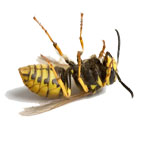Eraddapest provide the following services.
Below is a list of our most common services. This list is not complete and if you require a service which is not listed please use one of the contact methods listed and one of our fully trained members of staff will answer your questions.
Ants - Ants may travel large distances in search of food. Even the cleanest of homes can provide a ready food source for ants which once found can invade in large numbers, such that professional help is required.
Birds - More than 60 transmissible bird diseases (some of which are fatal) are associated with geese, pigeons, starlings and house sparrows.
Cockroaches - Cockroaches carry food poisoning germs on their bodies and are responsible for the spread of dysentery and gastro-enteritis.
Foxes - Foxes harbour many parasites and diseases. There are considerable numbers of studies on parasites and diseases of foxes dealing with prevalence in foxes, disease spread and aspects of transmission to people and animals. Much research has focussed on rabies, the fox tapeworm (scientific name Echinococcus multilocularis) and the sarcoptic mange mite.
Flies - There are many kinds of fly which can make a nuisance of themselves but houseflies and bluebottles are particular pests each summer. Though they are similar in many ways, there are some differences between them, which may be important when it comes to dealing with the problems they cause, so being able to tell them apart can sometimes be a big help.
Mice - Mice like rats are a major health hazard. They are responsible for the spread of many diseases, some of which can be fatal to man. They can eat food, which is intended for human consumption, and contaminate much more with their urine, droppings and fur.
Minks - Mink are opportunistic feeders and carnivores. They have been known to take a wide variety of prey including birds (ducks, cygnets, moorhen etc,) water voles, rabbits, and a variety of small mammals.
Moles - Mole holes are unsightly on lawns and can be disruptive to the rootsystems of garden plants. Moles lurk in their subterranean fortresses throughout the year. But gardening and lawn-care enthusiasts are made acutely aware of the need for mole control mainly during the spring and fall, especially after periods of rain, when moles push mounds of dirt up to the ground surface.
Pigeons - Feral pigeons carry diseases that are harmful to man, significantly more than the brown rat and yet people would not normally dream of feeding rats! The best known disease passed from birds to man is Psittacosis but over 40 more diseases can be passed from feral pigeon to humans, including potentially infectious diseases such as salmonella, tuberculosis and ornithosis.
Rabbits - Rabbits have a remarkable ability to circumvent fences and raid vegetable gardens. One can of course shoot, trap, or gas them; but by then a good deal of damage has been done, and more may occur before the offending rabbit or rabbits are dispatched.
Rats - Rats are of particular public health importance because of their close association with humans, of the many diseases caused by rodents and rats in particular, the most infamous is the plague. This is caused by a bacteria transmitted to man from rats by the rat flea.
Silverfish - Silverfish and firebrats eat a wide variety of foods, including glue, wallpaper paste, bookbindings, paper, photographs, starch in clothing, cotton, linen, rayon fabrics, wheat flour, cereals, dried meats, leather and even dead insects.
Squirrels - Squirrels are often seen in the garden, and can be a nuisance there. Unwanted visitors in your loft can be both destructive and very noisy, especially at night-time.
Wasps - Wasps are very well known. These conspicuous buzzing insects have yellow and black striped, wasp-waisted bodies, approximately 10-15mm long.They have a sweet tooth at one end and a painful sting at the other. The wasp is found in all the countries in the world, on every continent with the exception of the polar regions.Wasps are omnivorous animals and therefore eat a mixture of plants and other animals. As with bees, the wasp prefers the sweeter plants and primarily eats nectar, fruits and honey. Wasps also eat insects and even large caterpillars.Wasps are not a public health pest, but they do cause a nuisance to people, often in late summer when the workers forage for sweet substances such as fermenting, over ripe fruit. It is at this time of year that wasps can become aggressive and are most likely to sting humans and pet animals if provoked. For most people the sting is irritating, however, for people who are allergic, being stung by a wasp can pre-empt anaphylactic shock, and be a matter of life or death.
All worker wasps die out during the winter, and the only wasps that survive are the queen wasps. As the cold weather approaches, queens find a suitable place to hibernate, often in an existing nest or they construct a small hibernation cell.
kent, maidstone, wasp control kent, pest control medway, pest control kent, wasp nest removal medway, wasp removal gravesend, wasps medway, fox removal, fox trapping, professional wasp nest removal medway, rodent removal, squirrel removal, humane trapping, rat trapping, pest poisons, pest trapping, mouse removal, mouse trapping, rat catching, ants nest removal, bird removal, pigeon proofing, cockroach removal, cockroach treatment rochester, fly removal, fly treatment, mink treatment service, mole treatment, mole removal, rabbit prevention service, pest control contracts, vermin control rochester, mice control, sittingbourne, gravesend, bexleyheath, dartford, faversham, kent, medway, rochester, maidstone,wasp nest removal rochester,wasp nest medway,wasp nests medway,how to get rid of wasps maidstone,hornet nest medway,hornet nests maidstone,removing wasp nests maidstone,wasp controller maidstone,wasp nest removal company medway,wasp nest removal companies medway,get rid of wasps maidstone,how to remove wasp nest medway.


